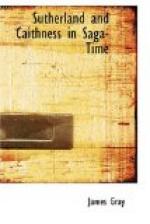O. and S. for Tudor’s Orkney and Shetland.
B.N. Burnt Njal.
And see List of Authorities (ante) for
full titles of Books referred
to. Save where otherwise stated the
references to the Sagas
are to the chapters not pages_.
NOTES
CHAPTER I.
[Footnote 1: Rhind Lectures 1883 and 1886, and see The County of Caithness, pp. 273-307.]
[Footnote 2: Royal Commission 2nd Report, 1911, and 3rd Report, 1911; see also Laing and Huxley’s Prehistoric Remains of Caithness, 1866.]
[Footnote 3: Survivals in Belief among the Celts, 1911.]
[Footnote 4: Tacitus, Agricola 22-28.]
[Footnote 5: Coille-duine, or Kelyddon-ii.]
[Footnote 6: H.B., vol. i, p. 5.]
[Footnote 7: Anderson, Scotland in Pagan Times, p. 222. Two plates of brass found in Craig Carrill Broch. Copper 84%, tin 16%.]
[Footnote 8: See Laing and Huxley’s Prehistoric Remains in Caithness, Laing ascribes a much greater antiquity to the Burgs, pp. 60-61. See Skene, Chron. Picts and Scots, pp. 157-160 as to a legend of their Scythian origin, and p. xcvi and p. 58.]
[Footnote 9: See Reeves’ Life, and see H.B., vol. i, pp. 12-15; also Dr. Joseph Anderson’s Scotland in Early Christian Times, 1879, p. 139.]
[Footnote 10: H.B., vol. i, pp. 10-17.]
CHAPTER II.
[Footnote 1: See MacBain’s note at p. 157 of Skene’s Highlanders of Scotland.]
[Footnote 2: For the boundaries of Sutherland, see Sir R. Gordon’s Genealogie of the Earles, pp. i and 2, and map hereto.]
[Footnote 3: In Ness the subjacent stone is too near the surface to have ever admitted of the growth of large trees.]
[Footnote 4: Scrope, Days of Deerstalking, 3rd edit., pp. 374-377.]
[Footnote 5: Curie’s Inventories of Monuments, &c., 1911 (Caithness) 1911 (Sutherland), and see his maps. Why are there no brochs in Moray, Aberdeenshire and the Mearns? Did the Picts come there from the west and south-west coast after the age of broch-building, driven before the Scots, first eastward, then north into the Grampians?]
[Footnote 6: For example in Loch Naver.]
[Footnote 7: Anderson’s Scotland in Pagan Times, pp. 174-259.]
[Footnote 8: See Munro’s Prehistoric Scotland, p. 356.]
[Footnote 9: Often spelt Mormaor. See Ritson, Annals of the Caledonians, pp. 62-3.]
[Footnote 10: See Scotland in Early Christian Times (Anderson), pp. 141-2.]
[Footnote 11: Despite The Pictish Nation, pp. 69 and 401. But see Skene, Chron. Picts and Scots (Annals of Tighernac) p. 75, where 150 Pictish ships are said to have been wrecked in 729 A.D.]




